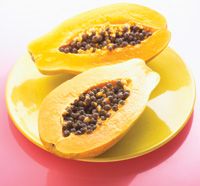No Chain, No Gain

Enzymes are often said to resemble Lego bricks because of their interlocking amino acid chains. But making an effective enzyme supplement isn't just child's play.
According to Robert Krueger, PhD, a professor of pharmacognosy at Ferris State University's College of Pharmacy (Big Rapids, MI), manufacturers need to watch out for a number of factors that can affect the potency of enzyme supplements.
In a presentation during the general science session of the Council for Responsible Nutrition's (CRN; Washington, DC) 2007 Annual Symposium on Dietary Supplements, held October 13–16 in Scottsdale, AZ, Krueger, who is spending a six-month sabbatical with CRN, stressed the idea that it takes active and stable enzymes to make credible and effective products.
CHAIN REACTIONS
To understand why the stability of enzymes is important, it helps to consider the chemical structures of enzymes and other proteins, which mostly consist of amino acid chains. The smallest proteins typically contain 50–75 amino acids, but larger proteins are composed of hundreds or even thousands of amino acids.
As the chains get larger, they bend into three-dimensional structures. Like Lego bricks, they consist of the same basic parts but can be assembled into a multitude of configurations. In enzymes, uniquely shaped regions of the structures known as active sites latch onto complementarily shaped receptor sites in other molecules, initiating chemical reactions.
Unlike most other proteins, enzymes possess the ability to accelerate chemical reactions that convert substrates into new molecules.
"Catalytic activity is the ability to facilitate a specific chemical reaction under bodily conditions that normally wouldn't occur otherwise," Krueger said. "We could wait forever for a substrate to magically turn into a product, but in the presence of an enzyme, it could be done in a millisecond or a microsecond-or less."
Enzymes May Lead to Safer, More-Appealing Baked Goods

In 2002, Swedish health authorities announced that they had found acrylamide in snacks like French fries and crackers. While subsequent tests suggested that the chemical may be toxic to animals, data on acrylamide's effects on humans is limited.
Acrylamide is formed when starchy foods are exposed to high heat. The heat causes sugars to react with the amino acid asparagine, a precusor to acrylamide.
In August, Novozymes (Bagsvaerd, Denmark) and DSM Food Specialties (Delft, The Netherlands) both unveiled new enzyme products that reduce the amount of acrylamide in food applications.
Acrylaway from Novozymes and PreventASe from DSM both contain the enzyme asparaginase, which converts asparagine into aspartate, preventing the formation of acrylamide. The enzyme doesn't affect other characteristics such as flavor or browning.
"Food manufacturers can now offer end-consumers food products with reduced worries regarding acrylamide," Peder Holk Nielsen, executive vice president of sales and marketing for Novozymes, said on August 31. "Many food manufacturers globally have already tested Acrylaway and have shown interest in the product and its ability to substantially reduce acrylamide without changing the taste and appearance of their food product."
DSM and Novozymes both say the enzyme can reduce acrylamide in baked goods by as much as 90%, depending on the application.
"Our enzyme has been available for a couple of months for food manufacturers, and we see that actual uptake is picking up now," DSM business development manager Judith Heikoop said on August 31.
Catalysis usually proceeds smoothly. However, a range of external forces, including temperature, pH, pressure, contaminants, and physical shock can all affect an enzyme's structural integrity, hindering its ability to plug into receptor sites and initiate a reaction.
"Whether we are talking about proteins or enzymes, if we have an anomaly in any part of the structures, we don't end up with the function we want," Krueger said, adding that the process of changing an enzyme's structure known as denaturation often leads to deactivation.
Krueger used a kitchen analogy to explain the process. "If you take a liquid egg out of an eggshell and cook it, you get a white solid with a congealed yoke," he said. "If you take it out of the frying pan and put it back in the refrigerator, it doesn't liquefy, does it? Denaturing is a one-directional phenomenon."
"So question your product," Krueger added. "If you have a claim on your label that says ‘digestive aid' and you have an enzyme that is no longer active, you don't really have a digestive aid. You have a little piece of protein that is not going to aid digestion."
Krueger cautioned that, despite some marketing claims to the contrary, enzyme weight does not equal enzyme activity. "I see lots of enzyme products on the market that have a ‘weight of enzyme' designation," he said, adding that activity is essential for product integrity. "You want to deliver an active enzyme to your customer because your customer wants the product to work for them. If it's not active, it's not going to work."